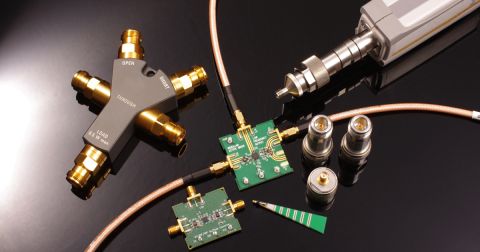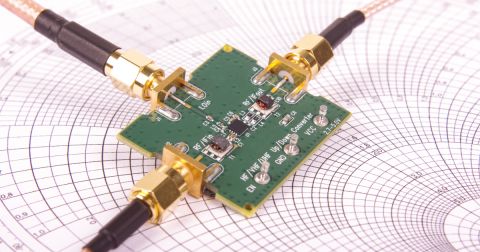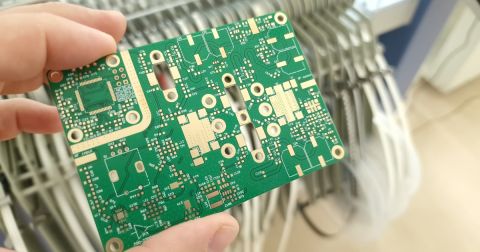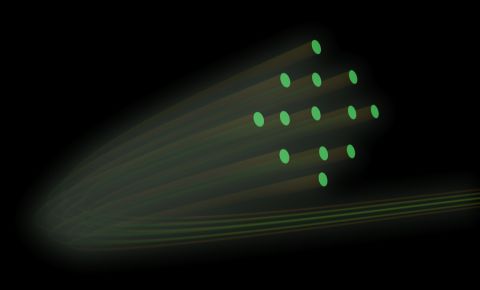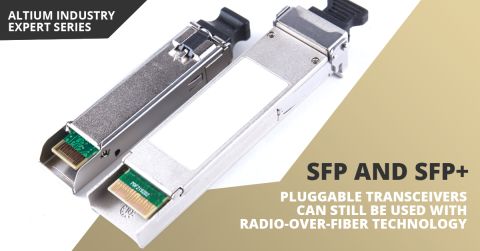Designing a Multiphase Buck Converter for an RF Power Supply

It seems like just yesterday we were talking about future 5G rollouts, and now the initial 5G networks are already coming to life in the US, China, and South Korea. 5G systems are changing the way designers approach base station and transmitter equipment, as well as handsets, automobiles, repeaters, and IoT products. Further expansion in 5G rollouts can’t happen without greater innovation in base stations and expansion of transmitter equipment to small, localized cells so services can be delivered to users.
Among the set of base station equipment you will find in the field, RF power supplies and amplifiers play a central role in signal transmission, and RF power supplies must be designed to support signaling in these systems with high efficiency. Unfortunately, the earlier generation of Si, SiC, and GaAs power MOSFET products is generally unable to dissipate enough heat away from active devices so that the devices can stay cool. We saw a variation of this heating problem in the summer of 2019, when the 5G modems in new smartphones were shutting down due to overheating. A similar problem happens in base stations.
Normally, you need to use components like heat sinks or fans to keep power amplifier stages cool as they generate heat during operation, particularly when they are powered with a DC supply. RF transmitter systems need to dedicate a lot of space to heat sinks, a bulky enclosure, fans, and other cooling equipment. Getting to a smaller RF power supply footprint with higher efficiency takes a few simple but important steps:
- Using newer semiconductor devices like GaN FETs on SiC
- Using alternative regulator topologies for power supplies and amplifiers, such as multi-phase buck converters with envelope tracking
In this article, we’ll look mostly at the second point, particularly one regulator topology that enables higher power conversion efficiency in RF power supplies and amplifiers: a multiphase buck converter. As we walk through this design, I’ll show an example that uses GaN MOSFETs as the switching element in this converter, and how this type of converter is integrated into a power supply for RF systems. This type of power supply design is intended to deliver stable power to RF emitters with frequency-modulated signals.
Envelope Tracking Power Supplies
A preferred way to deliver DC power to RF power amplifiers is to use an envelope tracking power supply. I won’t get into the particulars of how to design this particular type of power supply, and I’ll leave that for another article. The major advantage of using envelope tracking is less heat dissipation during operation. An envelope tracking power supply tracks the overlaid amplitude envelope of the modulated signal that is drawn through the amplifier. In this way, the power supplied to the amplifier increases or falls at the same instants as the input signal, so less power will be dissipated as heat when the internal FET is nearing its OFF state.
These systems tend to have higher peak to average power ratio (PAPR) than comparable power systems that don’t use envelope tracking. Numerous types of envelope tracking power supplies have been used in linear amplifiers, switching converters, and converters with linear assisted switching. The goal in reducing power lost as heat in the amplifier is to ensure high efficiency. High bandwidth envelope tracking implemented in an RF power supply requires precise regulation with low noise. Contrast this with digital systems, where switching noise is much less important than transients on the power bus.
For this application in envelope-tracking RF power supplies, we would prefer a multiphase buck converter. This type of buck converter uses multiple driving stages that have an enforced phase delay to drive a standard LC arrangement you’d find in a standard buck converter circuit. We would want to use this type of buck converter for three reasons:
- By running at low duty cycle and by setting a defined phase relation, the current in the output inductor will see a higher switching frequency, which is beneficial for low noise.
- Due to #1, driving at higher combined switching frequency allows you to use a physically smaller inductor if desired.
- Although the equivalent switching frequency that drives the output inductor will be high, you can still drive individual switching stages at lower frequencies.
- With an appropriate inductor or phase-delayed driver, zero-voltage switching (ZVS) can be implemented, further reducing losses during soft switching.
Multiphase Buck Converter Design
The block diagram below shows, at a high level, the basic design concept and topology of a multiphase power converter. Phase control is implemented across multiple switching stages, all of which are placed in parallel. These then share an output bus, where the output is passed through a low pass filter to reduce ripple.

The image below shows an example schematic for one of the switching sections in a multiphase converter. The switching stage is the most complex portion of these systems. The output from each section (from L1 in each section) connects in parallel to a long bus, all of which converge on the output port connecting to the output filter. A pi filter is an excellent choice for implementing passive envelope tracking, which performs the same functions as in a standard (single-phase) buck converter (low-pass differential mode filter).

This design could conceivably be run at ~100 MHz switching frequencies with ZVS as long as the right high-frequency PWM driver is used. The 4th order output filter shown above provides envelope tracking within the required bandwidth. The timing diagram below shows how voltage control is implemented across the high-side flying capacitor (VCa) at an output level ranging between Vin/2 and Vin for 0.5 < D < 1.0. The total output current still contains some ripple, but at 4x the frequency compared to the switching frequency on the high and low side MOSFETs.
The flying capacitors (Ca and Cb) play important roles here and have the same function as in a typical single-phase buck converter: to charge and discharge periodically when the MOSFET array switches, thereby delivering power through the output inductors. I’d like to point out one important conclusion you can draw from the above graph that may not have been obvious earlier:
A multiphase converter behaves like a single-phase converter driven at N-times the frequency, or with N-times the output inductance.
This is your core advantage of a switching converter. Combined with envelope tracking and some low RON GaN FETs, power drawn from this supply by an amplifier will have much less noise but with smaller footprint and lighter cooling demands. Now, we need to choose some GaN FETs and output inductors for each phase.
Inductor Selection
To implement this type of system, the next task is to select the FETS and inductors (marked L1 on the high and low sides) used in the design. These inductors are important for driving ZVS when the drain-source voltage values in the transistors are switched by the driver. In this type of application, GaN FETs and MMICs are most preferable for use as the switching elements in power systems for their low RON values and high thermal conductivity, which dumps heat into the PCB substrate or to a nearby heatsink.
While it might not be obvious, the inductor in this system needs to be properly sized to reach ZVS. This switching condition is reached by selecting the appropriate value of L1 such that the peak-to-peak ripple current is more than twice the value of the average current. Normally, to implement ZVS, you would need to use a complex control circuit, where the output current would be dynamically limited between ZVS cycles.
Next, we come to the inductor L1, which should be designed to accommodate the desired duty cycle range. For an N-phase three-level converter, the maximum value of L1 required to reach ZVS in the high side switches Q1 and Q2 with a load resistance RL, duty cycle D, and equivalent switching frequency fs,eq is:

The duty cycle in these converters can range from as low as 0.1 to 0.9; L1 should be determined at maximum or minimum value of D. This converter will be connected to the power amplifier input, which will drop to low impedance when the amplifier receives its driving signal.
Finally, the f term in the above equation (equivalent frequency) is shown below. Notice that, for N = 2, we get quadruple the driving frequency, just like we’d expect from the above graphs.

FET Selection
For high frequency designs, such as the example here for 4G LTE and higher operating frequencies, power systems need to go beyond Si power MOSFETs. GaN FETs are the ideal device at this time as they have lower ON-state losses at higher frequencies where Si would be unusable. The closest counterparts are GaAs and SiGe, but these material platforms still underperform at mmWave frequencies where high efficiency power conversion is needed.
There are a few reasons you want something beyond Si MOSFETs for this type of RF power supply:
- Lower gate capacitance
- High mobility in the inversion layer vs. bulk layer
- Higher device temperature limits
- Higher breakdown field
- Higher thermal conductivity
- Lower capacitance
- Deeper saturation during driving
Take a look at some Octopart search results to see some example components. Once you’ve selected your FETs, you can look at a simulation with an arbitrary driving signal to determine the power conversion efficiency of this regulator design. You could do this with a SPICE simulation as long as a real model for your switching FETs is available. Here, you’ll want to compare the time-averaged output power (using the output voltage Vo) delivered to the load to the voltage across the flying capacitor for various duty cycles.
Another major circuit challenge here is connecting the FET arrays in series. I discussed parallel MOSFET arrays in the past, which are known to oscillate if not wired with a bit of resistance in the array output. Series FETs are actually more difficult to deal with in power systems, especially when there is a high input voltage into the switching section. In a series arrangement, the goal is to ensure the voltage is evenly distributed across the design, something that is quite difficult as the junction resistance is nonlinear, depending on the gate voltage. In general, the first FET in the series array dissipates the most voltage, so it will fail first. I’ll look at this more in an upcoming article as it’s an interesting problem, but the structure of CMOS buffers shows that it’s a fundamental problem in integrated circuit design.
Layout Tips for Multiphase Buck Converters
The essential points to think about in your layout are isolation, heat dissipation from your FET arrays, and distributing the voltage drop evenly across the FETs in your array as mentioned above.
- Isolation: Laying out the board with tight routing to ensure low inductance is the first step in preventing excessive EMI and noise received from downstream in the design. A nearby ground plane helps ensure low inductance routing and provides some shielding.
- Placement: Given the series arrangement of FETs and the need to place nearby PWM controllers, I would place everything along a linear arrangement to ensure RF power pulled from the design does not couple back to the input side of the design.
- Heat dissipation: Advanced FETs you would need in an RF power supply dissipate a lot of heat, and that heat needs to go somewhere. A nearby plane is a good option as heat can then conduct away from the FETs. A thermal interface material between the board and the enclosure will also help remove any heat generated in the supply.
If you’re looking for the best set of circuit design and PCB layout utilities for modern electronics, use the complete set of PCB design tools in Altium Designer®. When you need to evaluate power integrity and EMI in your design, Altium Designer users can use the EDB Exporter extension to import their design into Ansys field solvers and perform a range of SI/PI simulations. When you’ve finished your design, and you want to release files to your manufacturer, the Altium 365™ platform makes it easy to collaborate and share your projects.
We have only scratched the surface of what’s possible with Altium Designer on Altium 365. Start your free trial of Altium Designer + Altium 365 today.

